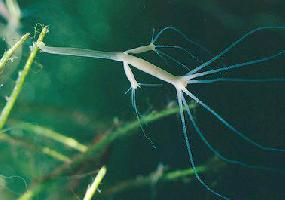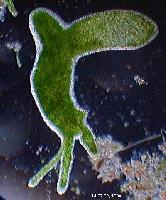
Súlyok és méretek
| Hossz | 1-tól 1,5-ig cm |
|---|
Állatleírás
The Brown Hydra, scientifically known as Hydra oligactis, is a fascinating freshwater animal belonging to the phylum Cnidaria, which also includes jellyfish, corals, and sea anemones. This species is particularly known for its remarkable regenerative abilities and simple, yet intriguing, biological structure. The Brown Hydra is a small creature, typically measuring up to 10-15 millimeters in length, though its size can vary depending on environmental conditions and the availability of food.Characterized by its tubular body, the Brown Hydra has a basal disc at one end that functions as a foot, enabling it to attach itself to submerged vegetation or other surfaces in its aquatic environment. At the opposite end is the mouth, surrounded by a ring of 5 to 10 tentacles. These tentacles are not only crucial for the hydra's mobility but also play a vital role in capturing prey. The body of the Brown Hydra is translucent, with a color that can range from a pale brown to a more pronounced brownish hue, depending on specific factors such as diet and light exposure.
The Brown Hydra is a solitary creature, but it can occasionally be found in clusters, especially in environments rich in food resources. It thrives in still or slow-moving freshwater bodies, such as ponds, lakes, and calm streams, where it feeds primarily on small aquatic organisms. Its diet mainly consists of tiny invertebrates, which it captures using the nematocysts contained within its tentacles. These specialized cells discharge a paralyzing toxin that immobilizes the prey, which is then drawn into the hydra's mouth by the tentacles.
One of the most remarkable aspects of the Brown Hydra is its incredible regenerative capability. It can regenerate its entire body from just a small fragment, a trait that has made it a subject of extensive scientific study, particularly in the fields of developmental biology and regeneration. This ability is also linked to the hydra's potential for biological immortality, as it can continually renew its cells and avoid the aging process that affects most other organisms.
Reproduction in the Brown Hydra occurs both sexually and asexually. Asexual reproduction is the more common method and takes place through a process known as budding, where a new individual grows directly from the body of an existing one. Sexual reproduction, on the other hand, occurs less frequently and usually in response to specific environmental triggers, such as changes in temperature or food availability. During this process, the hydra develops reproductive organs (gonads) on its body, with some individuals producing eggs and others producing sperm, leading to the fertilization of eggs and the development of new organisms.
The Brown Hydra's simple yet efficient biological design, its predatory behavior, and its remarkable regenerative abilities make it a creature of great interest not only to biologists and ecologists but also to anyone fascinated by the diverse and intricate forms of life that inhabit Earth's freshwater ecosystems.
Hasonló állatok
Új állatfotók
Top 10 állat
- Diana monkey (Cercopithecus diana)
- Dolphin gull (Leucophaeus scoresbii)
- Moustached guenon (Cercopithecus cephus)
- Galápagos tortoise (Geochelone nigra complex)
- Stone loach (Barbatula barbatula)
- Japanese spider crab (Macrocheira kaempferi)
- Common house mosquito (Culex pipiens)
- Colossal squid (Mesonychoteuthis hamiltoni)
- Common reed warbler (Acrocephalus scirpaceus)
- Sea urchins (Echinoidea)
